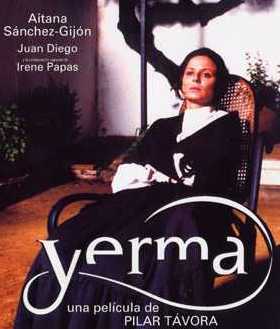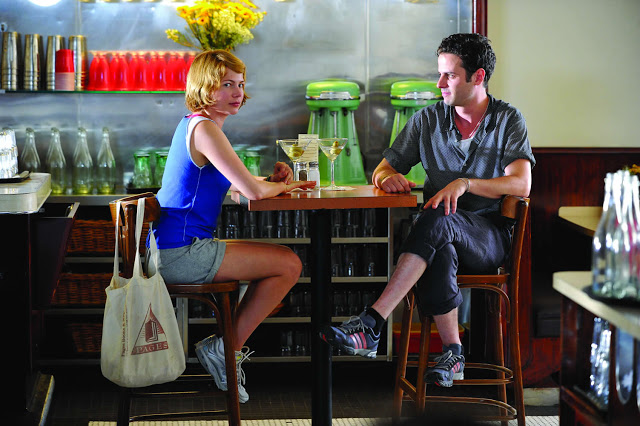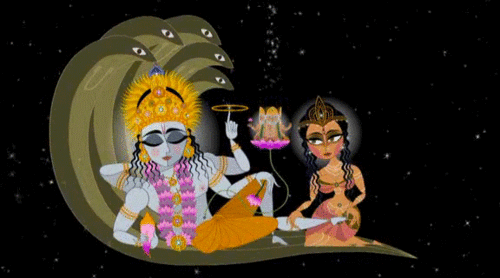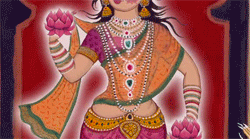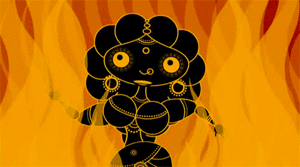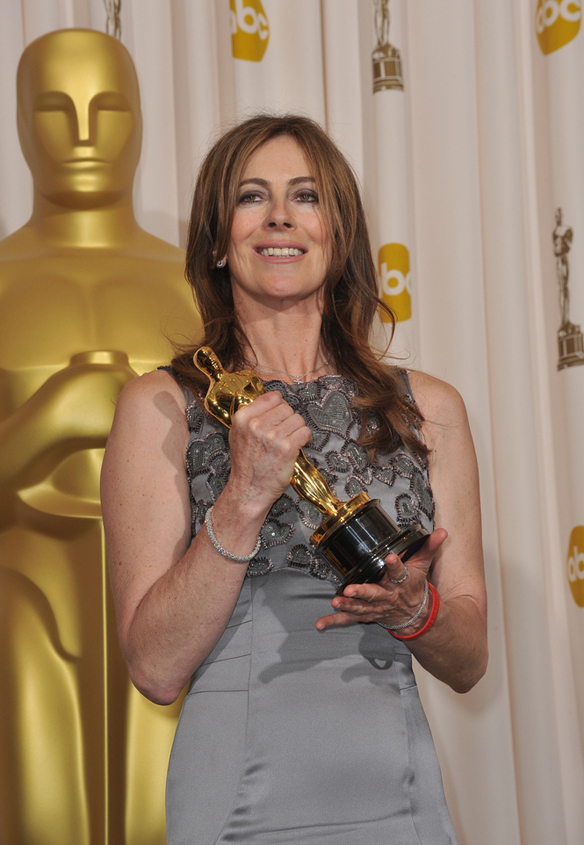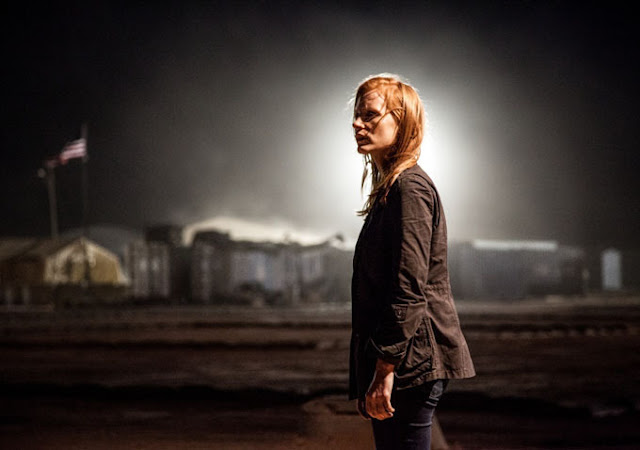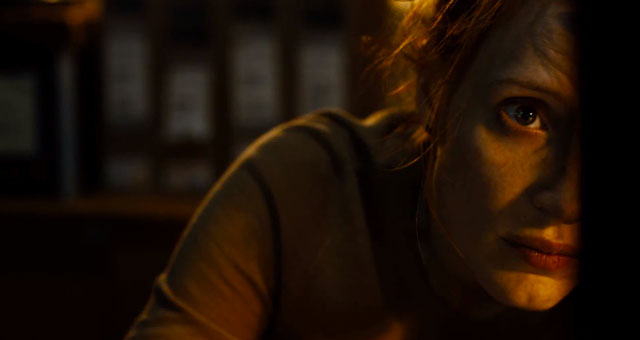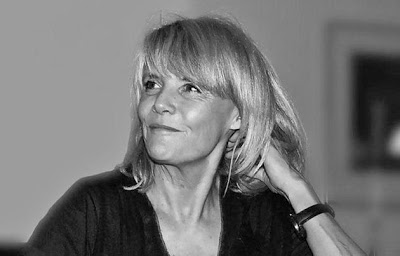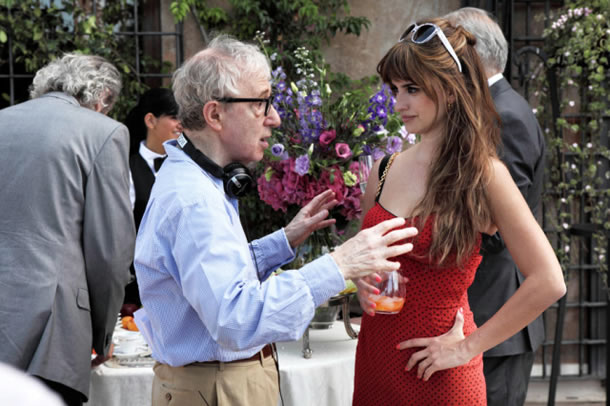 |
| Movie poster for Yerma |
Written by Leigh Kolb for our theme week on Infertility, Miscarriage, and Infant Loss.
My womb is opening / without fear or dread /
and on white sheets / I sketch my dream.
Let us sing / let us sing / let us sing.
For life is woven in the early morn,
For the silvery moon an infant will bring.
In 1934, Spanish writer Federico García Lorca wrote the play Yerma, and it has been performed regularly since its opening that year. In 1999, a Spanish film was released, directed by Pilar Távora.
Yerma, the title character, has been married to Juan for two years and she has not been able to get pregnant. (Yerma means “barren” in Spanish.) As the film opens to folk songs with poetic lyrics that weave throughout the entire film, Yerma is taking care of him, trying to get him to drink milk and exercise more. It’s clear his work drives him–he works hard, and is tenacious in his work in the field, but not in love.
 |
| Juan and Yerma appear happy on their wedding night |
Yerma seems to just be starting to devolve into an incredibly unhappy mental and emotional place in regard to their inability to conceive.
Her friend Maria visits, and she’s brought lace, ribbon and fabric. “It’s happened!” she says, and Yerma is excited for Maria’s pregnancy, asking her how she feels, and giving her loving advice. Yerma seems to have a deep understanding of pregnancy and motherhood, and displays wisdom with Maria.
Maria asks about the fact that Yerma has no children, but assures her that she’s had friends who took longer to conceive. “Two years and 20 days is too long,” asserts Yerma. “It isn’t fair that I’m wasting away here.”
Before she leaves, Maria pulls out her new fabric and lace and asks Yerma to sew little dresses for her, since she “sews so well.” Yerma graciously complies.
 |
| Yerma has tried for years to become pregnant, and her friend announces she’s gotten pregnant after just a few months of marriage. |
The first scenes are familiar ones to infertile women–trying to watch after the health of her partner, tension over the desire to conceive, a friend getting pregnant after just a few months and the pain of knowing more about pregnancy than the pregnant friend herself.
Sorrow wide as a field / a door closed on beauty
I beg the suffering of a child
But the wind gives me dahlias / from under the sleeping moon
Sorrow wide as a field / I beg the suffering of a child
As time passes, it becomes clearer that Yerma’s marriage is an unhappy one. Her father arranged her marriage to Juan, but her true match seems to be Victor (who Juan runs off after he’s concerned that he and Yerma have been speaking too much). Indeed, Juan doesn’t even like Yerma going outside of the home at all.
Yerma meets an old woman on the path to the field, and she clings to her, begging her to answer questions about her childlessness since she assumes an older woman would have wisdom. Yerma says she’s been thinking about children since the moment she was engaged. “I was just the opposite,” the old woman says. “Maybe you’re thinking too much.”
Yerma says she still remains empty, but she’s “filling up with hate.”
The old woman alludes to the fact that God has no part in this, and if there was one, there should be a god who “sends lightning bolts to men with spoiled seed.” This is the first real indication that perhaps Juan is the problem (the old woman tells Yerma later that it is Juan, and he’s from a long line of men with the same problem).
Yerma goes back home and meets other women on the road who are hurrying to take their husbands lunch. One left her baby home alone, and the other talks about adamantly not wanting children and being bitter about spending her whole life cooking and washing–things that she doesn’t want to do. Yerma reacts harshly to the young mother who’s left her child at home, again reinforcing that sadness in infertile women of seeing others take parenting for granted.
Yerma changes after these encounters–Juan’s coldness and lack of desire for her or for children has become clearer to her, and the older woman’s warnings and sharp words start sinking in. When we see her again, she’s rocking back and forth in the dark, while we hear women gossip about her.
It’s a pity of the childless wife / It’s a pity of the woman whose breasts are dry
Time has passed, and a group of women is doing laundry and talking about Yerma.
“They don’t like to make lace or jam,” one woman says about barren women. “They like walking barefoot on the river.”
“It isn’t her fault she doesn’t have children,” her friend interjects.
“Whoever wants children has them,” another says.
“It’s all his fault.”
“It’s all her fault.”
The women have largely turned against Yerma as she has turned inward and become increasingly full of grief over her desire to and inability to conceive.
She and Juan lash out at one another. He says, “You keep beating your head against a wall. I feel uneasy living with you, anxious. You have to resign yourself.”
She responds, “I want to drink water, and there’s no glade and no water. I want to climb a mountain and I’ve got no feet. I want to trim my petticoats and I can’t find the thread.”
Yerma’s words about the deep, miserable feelings surrounding infertility are poignant and heartbreakingly accurate. While much is going on in this film worth discussing–the patriarchal culture that arranges marriages and ties a woman’s worth solely to her ability to have children, obviously, and the immediate blame of the woman when a couple can’t conceive–Yerma’s struggle with infertility is one of the most accurate portrayals of that grief that I’ve ever seen.
 |
| Yerma slips deeper into an obsessive depression as time goes on. |
Yerma sees Maria walking quickly by her house, and asks her to stop. She wonders why she’s rushing by and Maria says, “Because you always cry.” Yerma holds the baby and kisses it.
“Women who’ve had children cannot imagine not having them,” she says. “My longing grows stronger and my hopes are fading.”
Yerma visits a group of older women who chant over her, praying to Sainte Anne, performing a ceremony in the cemetery in the middle of the night. Afterward, the older women gently criticize Yerma for “fretting” too much about not having a child and not taking shelter in her husband’s love. Yerma becomes defiant, and finally exclaims that she doesn’t love him. “But he’s my only hope,” she says. “For my honor and my family. My only hope.”
She seems relieved. “I needed to talk,” she tells the women. The female conversations in the film are both destructive and nourishing, but they are clearly good for Yerma when she is able to be a part of them.
Yerma continues to decline, though. Juan finally confronts her and tells her that he doesn’t like the idea, but he’s willing to take her himself to a pilgrimage where childless women go to be blessed with children.
At the ceremony, the old woman finds Yerma and tells her she should leave Juan and marry her son, instead, who could give her children. “What about my honor?” Yerma says, and tells her to go away. Yerma’s inability to conceive and her miserable marriage seem to fall squarely on the shoulders of Juan, but she cannot escape due to the strict morality of her culture.
“My pain has gone far beyond my body,” Yerma says.
The old woman calls her barren and Yerma repeats the word. “Since I’ve been married that word has been going around in my head,” she says, but “this is the first time I’ve said it out loud.”
Yerma runs through the woods and settles at her campsite, where Juan is drinking. She tells him to leave her alone, but he says he wants to speak.
“I won’t put up any longer for continual lament for things that aren’t real,” he says. “For things that haven’t happened, and that we can’t control. For things I don’t care about. I care about what I have in my hands.”
She says that’s what she’s been waiting to hear: that he doesn’t care.
Yerma speaks of a son, and says, “You never thought of him when you saw me long for him?”
Juan coldly says, “Never.”
After a few minutes, Juan moves over and tries to seduce Yerma. He’s forceful and rough. She starts to kiss him back, but she’s crying, and she snaps. She strangles him violently and kills him.
“Barren,” she says. “Barren for certain. Barren. And alone. Now I can rest without wakening in fright to see if my blood will tell me of new blood. My body is dry forever.” She begins to repeat, “My son.”
Maria walks up to her in horror, and Yerma keeps repeating that she has killed her son. “I’ve killed my own son. My son… my baby, my baby, my child.”
The film ends, with the dedication “to my children” as a post script.
Yerma is a beautiful film, and Yerma’s descent into grief-stricken madness is haunting and powerful. We so rarely see female protagonists, and for a female protagonist to have such a visceral struggle with such a common, yet underrepresented, issue as infertility is moving and incredibly important.
Yerma killing Juan at the end of the film is symbolic of her overcoming not only the patriarchal culture that has defined her by her inability to mother, but also her infertility. She doesn’t see killing Juan as a way to marry someone else and try to have children; she sees killing him as freeing herself from the disappointment of not getting pregnant. Extinguishing him extinguishes her hopes.
Infertility when one desperately wants to conceive is grief, obsession, emptiness and feeling completely powerless. Yerma lives in a time and place where she has nothing else except being a wife and a mother to define her, so the added pressure of being unable to conceive a child drives her to the breaking point. Juan has repeatedly kept Yerma inside of their house and away from the outside world. When he admits he doesn’t care about having a child and then tries to assault her, it’s all too much. She has to end the physical manifestation of her grief and disappointment.
Yerma proves that a film about a woman’s struggles can work, even if those struggles don’t produce the kind of action that Hollywood seems to think it needs. Yerma’s inner turmoil is palpable, and good writing and directing make her story real and compelling. The power of Yerma rests not only in its treatment of infertility, but also its larger commentary on what a culture that stifles women can lead to. Yerma’s infertility is tragic, and so is her world.
Oh woman, how great is your sorrow
A sorrow so piteous
Your tears are like lemon juice
Sour as your hope and your lips
———-
Leigh Kolb is a composition, literature and journalism instructor at a community college in rural Missouri.




